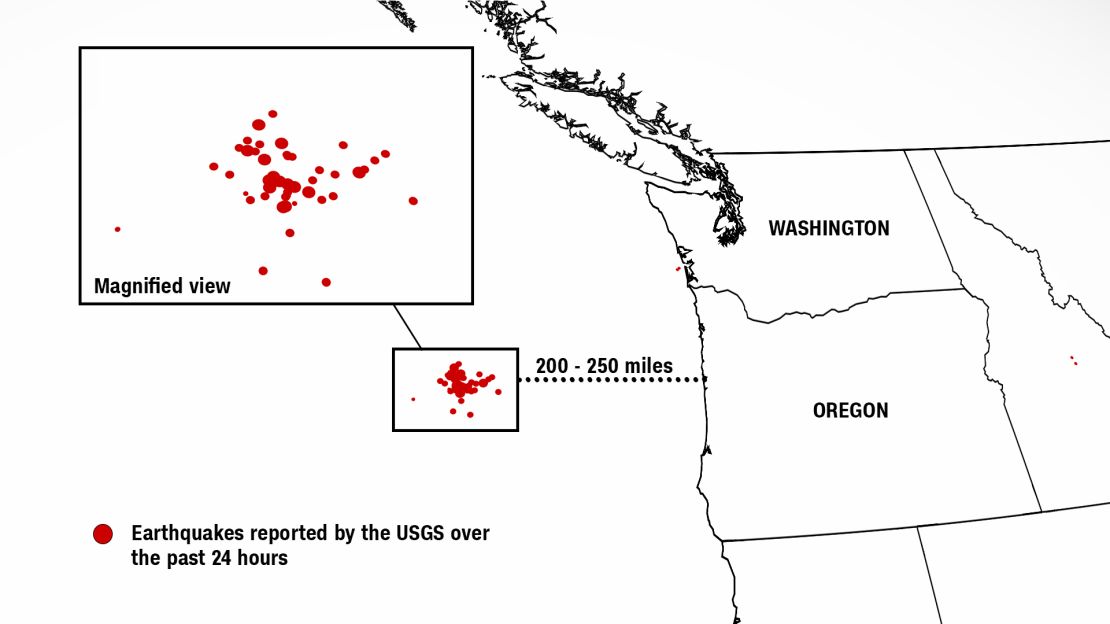The earthquake swarm off the Oregon coast continues – with almost 100 quakes in the past 48 hours – but experts say not to worry.
While the major concern with big earthquakes this far from land is the possibility of tsunamis, “events the size that have so far occurred in this swarm will not generate noticeable tsunamis,” writes the United States Geological Survey.
In addition, the fault line where the swarm is taking place – the Blanco Fracture Zone – moves side to side and isn’t the type of megathrust fault that displaces ocean water to form tsunamis. Such tsunami-producing earthquakes are more common on a nearby fault line.
“The main tsunami threat for the Pacific Northwest is the Cascadia subduction zone that lies ~360km (220 miles) to the east of this sequence.”
Meantime, the Blanco Fracture Zone shaking “can continue for days to weeks, or it can stop suddenly any time,” writes the USGS.
The series of quakes, which began early Tuesday morning and continued into Thursday, is clustered between 200 and 250 miles west of the coastal town of Newport, Oregon – far enough away to be mostly undetected on land.
But given the area’s seismic history, it is creating quite a buzz.

“If you had asked me (Monday) where on Earth would be most likely to produce a bunch of magnitude 5.0-plus quakes in a single day, this would have been high on my list,” Harold Tobin, director of the Pacific Northwest Seismic Network at the University of Washington state, told CNN.
The Blanco Fracture Zone is more active than the infamous San Andreas Fault in California, having produced more than 1,500 quakes of magnitude 4.0 or greater since the 1970s, an analysis by Oregon State University finds.
Not necessarily a precursor to the ‘big one’
What has been most impressive about this week’s quakes is the swarm has included at least nine tremors reaching a magnitude 5.0 to 5.8, with the majority occurring at a shallow depth of only 10 km (6.2 miles).
The sheer number of magnitude 5.0 or greater quakes in the region triples the annual average (three 5.0-plus quakes per year) since 1980, according to the USGS database.
There were also swarms in June and July of 2008 and in August 2009 according to the USGS.
Though the epicenter of this week’s swarm of quakes, the Blanco Fracture Zone, is among the most seismically active in North America, it rarely leads to destructive quakes.
The fault is some 275 miles west of the Oregon coastline and about 200 miles west of the Cascadia Subduction Zone, where the largest and most destructive Northwest quakes have historically taken place.
“Blanco Fracture Zone quakes are strike-slip (lateral motions of the crustal blocks on either side, rather than up-down displacement), so it is very unlikely for them to pose a tsunami threat, even if a bigger quake happened, like a magnitude 7.0, for example,” Tobin told CNN.
There have been more than 133 quakes of magnitude 5.0 or greater on the Blanco Fracture Zone since 1980 and have never been followed by something on land, according to seismologist Dr. Lucy Jones.
“Today’s quakes can be thought of as something like a main-shock and a swarm of aftershocks, the one distinction being that in this case, there’s not a lot of magnitude difference among them,” Tobin said.
Though this week’s quakes have raised the concerns the so-called “big one” could be near, Tobin assured it is not necessarily the case.
“There’s quite a lot of distance from these quakes to the Cascadia Subduction Zone,” he explained. “Our best current understanding of how stress transfers through the crust (and mantle) would suggest that these events don’t change stress on the subduction zone appreciably.”
Although there have been a remarkable number of magnitude 5.5+ quakes in a short period of time, he said, it is not inherently alarming but rather seismologically interesting.



















